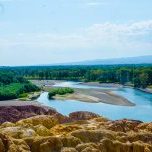By Xuefei Chen Axelsson
Stockholm, June 30(CED) — DNA reveals what the people on the warship Vasa from 1628 looked like.
A reconstruction made by Oscar Nilsson of a woman from the warship Vasa. Photographer/Source: Anneli Karlsson, Vasamuseet/SMTM New results from DNA analyses performed on skeletons from the Swedish warship Vasa show what the people on board looked like.More pieces of the puzzle have been put in place to offer a better picture of the people on board Vasa when the ship sank on its maiden voyage in 1628. Researchers now know the hair colour and eye colour of the individual known as ‘G’ and can also give an indication about how she dressed.“Based on new DNA analyses, we have concluded that the individual we call ‘G’ most likely had light hair, blue eyes and a light skin tone,” says Marie Allen, professor of forensic genetics at Uppsala University. Dr Allen performed the analyses in collaboration with Dr Kimberly Andreaggi of the Armed Forces Medical Examiner System’s Armed Forces DNA Identification Laboratory (AFMES-AFDIL) in the United States.“It’s possible today to get a lot of information through DNA analysis, such as sex and appearance,” continues Dr Allen, who together with Dr Andreggi earlier this spring revealed that skeleton G was not a man but a woman. “You can even see if the person had wet or dry ear wax, was lactose intolerant or liked coriander.”The new research results have already taken on practical significance. Oscar Nilsson, an archaeologist and a sculptor, has created an updated facial reconstruction of individual G.“I’m glad I now know that G is a woman, as well as what her eye colour and hair colour are,” Nilsson says. “Still, the reconstruction is my own interpretation of this person. Now it feels like I’ve gotten much closer to her – especially when her cap came into place. It really moved me to see her in her cap. It was like standing right in front of her on 10 August 1628. She has dressed up for this journey.” The cap in question was recreated by Anna Silwerulv, costume and textile researcher at the Vasa Museum. She and Nilsson have collaborated closely on the reconstruction that the researchers have begun to call ‘Gertrud’.“Parts of a woollen cap have been found near G’s skeleton,” Silwerulv says. “It really sparked my interest. Could it have been hers? The model seemed a little odd at first, but when I reconstructed it, the pieces fell into place. The size matched, and I also found blonde hairs in the fabric. I think we’ve found the answer. Under the microscope, you can clearly see that the cap was red.” Silwerulv continues: “Taking an interdisciplinary approach like this creates a more complete picture. The DNA tests give us the hard facts. Recreating the clothes is yet another vital part of understanding who these people were. They become individuals when we get to know them.”Researchers at the Vasa Museum are both studying the skeletons more extensively – through methods like osteological and isotope analyses – and examining personal belongings to find out more about the people who were on board Vasa. The DNA of the skeletons is still being studied, and Dr Allen of Uppsala University and Dr Andreaggi of AFMES-AFDIL will eventually present even more results from their genetic analyses. “We’ll be able to say more about several of the people on Vasa,” Allen says. “Right now, we’re looking at different types of information that we can obtain from their nuclear DNA. It’s nice to get to know them a little better as we get new results.” |

